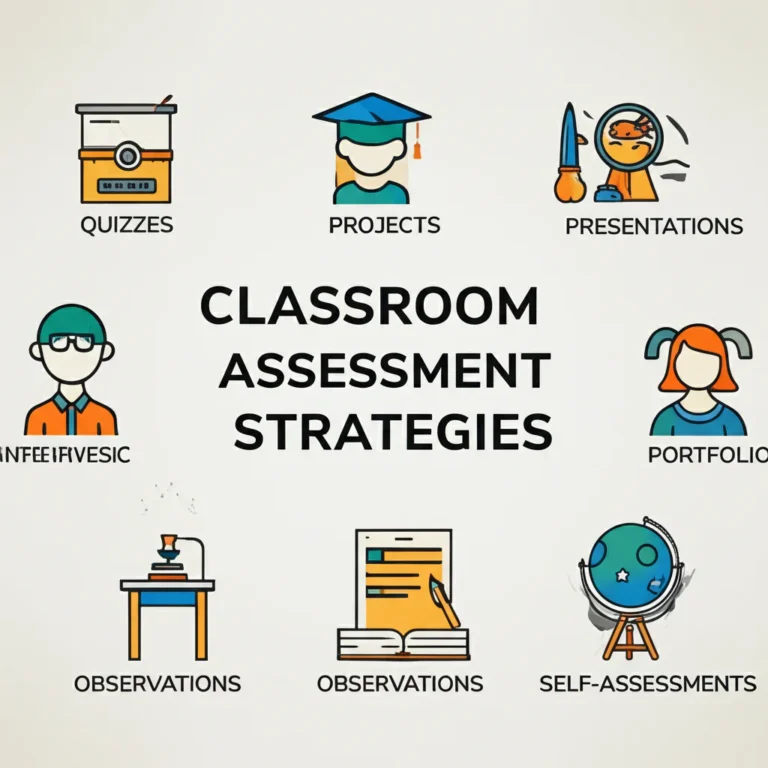Support our educational content for free when you buy through links on our site. Learn more
15 Formative Assessment Strategies to Transform Your Classroom in 2025 🎯
Imagine walking into your classroom and instantly knowing exactly where each student stands in their learning journey—no guesswork, no stress, just clear insights that help you tailor your teaching on the fly. Sounds like a dream, right? Well, with the right formative assessment strategies, this can be your everyday reality. In this article, we dive deep into 15 proven formative assessment techniques that not only boost student engagement but also empower you to adapt lessons dynamically for maximum impact.
From quick exit slips to cutting-edge digital tools like Padlet and Edulastic, we’ll explore practical, easy-to-implement methods that fit any classroom style. Plus, we’ll share real-life success stories and expert tips to help you overcome common challenges. Curious about how to make formative assessments work for diverse learners or how to integrate tech without drowning in data? Stick around—your ultimate guide awaits!
Key Takeaways
- Formative assessments provide ongoing insights into student understanding, enabling timely instructional adjustments.
- Diverse strategies—from low-tech exit slips to high-tech apps—keep students engaged and motivated.
- Aligning assessments with learning goals and standards ensures meaningful feedback.
- Incorporating student self- and peer-assessment fosters ownership and metacognition.
- Technology tools like Socrative, Kahoot!, and Google Classroom streamline data collection and analysis.
- Overcoming challenges like time constraints is possible with thoughtful planning and digital support.
Ready to revolutionize your teaching? Let’s get started!
Table of Contents
- ⚡️ Quick Tips and Facts on Formative Assessment Strategies
- 📚 The Evolution and Importance of Formative Assessment in Education
- 🔍 Understanding Formative vs. Summative Assessments: Key Differences
- 1️⃣ Top 15 Formative Assessment Strategies to Boost Student Engagement
- 2️⃣ How to Implement Effective Formative Assessments in Diverse Classrooms
- 3️⃣ Digital Tools and Apps for Formative Assessment: A Modern Educator’s Guide
- 4️⃣ Real-Life Classroom Examples: Success Stories with Formative Assessment
- 5️⃣ Common Challenges and Solutions in Formative Assessment Practices
- 📈 Research Insights: What Studies Say About Formative Assessment Effectiveness
- 🛠️ Practical Tips and Best Practices for Continuous Formative Feedback
- 🎯 Aligning Formative Assessment with Curriculum Standards and Learning Goals
- 🌍 Inclusive Formative Assessment: Strategies for Equity and Accessibility
- 📖 Recommended Resources and Professional Development for Educators
- 🤝 Connect with the Formative Assessment Community: Forums and Networks
- 🔚 Conclusion: Mastering Formative Assessment for Lifelong Learning Success
- 🔗 Recommended Links for Further Exploration
- ❓ Frequently Asked Questions About Formative Assessment Strategies
- 📑 Reference Links and Academic Sources
⚡️ Quick Tips and Facts on Formative Assessment Strategies
At Teacher Strategies, we specialize in strategies for success in the classroom, and formative assessment is a key area of focus. Formative assessment is an essential tool for teachers to understand students’ knowledge and engagement, allowing them to effectively adjust instruction. As the Poorvu Center for Teaching and Learning notes, “By measuring student understanding throughout a course, formative assessments enable students to reflect on how they can improve their own learning.”
Here are some quick tips and facts about formative assessment strategies:
- Definition: Formative assessment is an ongoing, flexible, and more informal process of evaluating student learning to improve instruction.
- Purpose: To gather evidence of student learning during instruction, allowing teachers to identify students needing extra help and adjust lesson plans accordingly.
- Benefits: Improve student learning by helping teachers understand misconceptions and areas of difficulty, boost student motivation, metacognition, and performance on summative assessments.
- Methods: Writing, quizzes, conversation, self-assessment, peer assessment, and more.
- Tools: Padlet, Poll Everywhere, Google Classroom, Google Forms, Edulastic, Socrative, Quizlet, and many others.
For more information on instructional strategies, visit our Instructional Strategies page.
📚 The Evolution and Importance of Formative Assessment in Education
Formative assessment has evolved over time, from traditional methods like quizzes and tests to more innovative approaches like project-based assessments and self-assessment. According to NWEA, “Using formative assessment in class during instruction—or ‘simple assessments,’ as they call them—is easy and provides the instant feedback teachers need to identify which learners need more help and adjust their instruction and lesson plans accordingly.”
The importance of formative assessment in education cannot be overstated. It helps teachers understand student learning, identify areas of difficulty, and adjust instruction to meet the needs of all students. As Edutopia notes, “Formative assessments generally just need to be checked, not graded, as the point is to get a basic read on the progress of individuals, or the class as a whole.”
🔍 Understanding Formative vs. Summative Assessments: Key Differences
Formative and summative assessments are two distinct types of assessments used in education. Formative assessments are used during the learning process to gather information on progress towards course objectives and to improve teaching. Summative assessments, on the other hand, are used at the conclusion of an instructional period to evaluate student learning, knowledge, proficiency, or success.
As the Poorvu Center for Teaching and Learning explains, “Formative assessments improve student learning by allowing teachers to better understand students’ misconceptions and areas of difficulty. They can also bolster students’ motivation to learn, their metacognition, as well as their performance on summative assessments such as exams.”
1️⃣ Top 15 Formative Assessment Strategies to Boost Student Engagement
Here are 15 formative assessment strategies to boost student engagement:
- Entry and Exit Slips: Utilize the beginning and end of class for quick checks on student recall and understanding.
- Low-stakes Quizzes and Polls: Gauge student comprehension with quizzes and polls designed for quick feedback.
- Dipsticks: “Alternative formative assessments” designed for speed and ease.
- Interview Assessments: Discussion-based methods to delve deeper into student understanding.
- Methods that Incorporate Art: Use visual or kinesthetic methods to assess understanding.
- Misconceptions and Errors: Focus on understanding why concepts are difficult or incorrect.
- Self-Assessment: Empower students to identify their own strengths and weaknesses.
- Peer Assessment: Encourage students to assess and provide feedback to their peers.
- Technology-Enhanced Formative Assessment: Utilize digital tools to facilitate formative assessment.
- Game-Based Formative Assessment: Use games and simulations to engage students and assess understanding.
- Project-Based Formative Assessment: Use project-based learning to assess student understanding and skills.
- Performance Tasks: Use performance tasks to assess student understanding and skills.
- Self-Directed Learning: Encourage students to take ownership of their learning and assess their own progress.
- Learning Journals: Use learning journals to assess student understanding and reflection.
- Class Discussions: Use class discussions to assess student understanding and engagement.
For more information on instructional coaching, visit our Instructional Coaching page.
2️⃣ How to Implement Effective Formative Assessments in Diverse Classrooms
Implementing effective formative assessments in diverse classrooms requires careful consideration of the needs and abilities of all students. Here are some tips:
- Differentiate Instruction: Use formative assessment to inform differentiated instruction and meet the needs of all students.
- Use Technology: Utilize digital tools to facilitate formative assessment and engage students.
- Make it Interactive: Use interactive and engaging formative assessment strategies to boost student engagement.
- Provide Feedback: Provide regular and timely feedback to students on their progress and understanding.
- Involve Students: Encourage students to take ownership of their learning and involve them in the formative assessment process.
For more information on classroom management, visit our Classroom Management page.
3️⃣ Digital Tools and Apps for Formative Assessment: A Modern Educator’s Guide
There are many digital tools and apps available to facilitate formative assessment. Here are some popular options:
- Padlet: A digital tool for creating and sharing online bulletin boards.
- Poll Everywhere: A digital tool for creating and sharing polls and quizzes.
- Google Classroom: A digital tool for creating and sharing assignments and assessments.
- Edulastic: A digital tool for creating and sharing formative assessments.
- Socrative: A digital tool for creating and sharing quizzes and assessments.
For more information on differentiated instruction, visit our Differentiated Instruction page.
4️⃣ Real-Life Classroom Examples: Success Stories with Formative Assessment
Here are some real-life classroom examples of success stories with formative assessment:
- Example 1: A teacher uses formative assessment to identify areas of difficulty for students and adjusts instruction to meet their needs.
- Example 2: A teacher uses technology-enhanced formative assessment to engage students and assess understanding.
- Example 3: A teacher uses project-based formative assessment to assess student understanding and skills.
For more information on assessment techniques, visit our Assessment Techniques page.
5️⃣ Common Challenges and Solutions in Formative Assessment Practices
Here are some common challenges and solutions in formative assessment practices:
- Challenge 1: Limited time and resources.
- Solution 1: Use technology-enhanced formative assessment to streamline the process.
- Challenge 2: Difficulty in interpreting results.
- Solution 2: Use data analysis tools to help interpret results.
- Challenge 3: Limited student engagement.
- Solution 3: Use interactive and engaging formative assessment strategies to boost student engagement.
📈 Research Insights: What Studies Say About Formative Assessment Effectiveness
Research has shown that formative assessment is an effective way to improve student learning and achievement. According to NWEA, “Formative assessments improve student learning by allowing teachers to better understand students’ misconceptions and areas of difficulty. They can also bolster students’ motivation to learn, their metacognition, as well as their performance on summative assessments such as exams.”
🛠️ Practical Tips and Best Practices for Continuous Formative Feedback
Here are some practical tips and best practices for continuous formative feedback:
- Provide Regular Feedback: Provide regular and timely feedback to students on their progress and understanding.
- Use Multiple Methods: Use multiple methods of formative assessment to get a comprehensive picture of student understanding.
- Involve Students: Encourage students to take ownership of their learning and involve them in the formative assessment process.
- Use Technology: Utilize digital tools to facilitate formative assessment and provide feedback.
🎯 Aligning Formative Assessment with Curriculum Standards and Learning Goals
Formative assessment should be aligned with curriculum standards and learning goals to ensure that it is effective in improving student learning. According to Edutopia, “Formative assessments generally just need to be checked, not graded, as the point is to get a basic read on the progress of individuals, or the class as a whole.”
🌍 Inclusive Formative Assessment: Strategies for Equity and Accessibility
Inclusive formative assessment strategies are essential for ensuring equity and accessibility in the classroom. Here are some strategies:
- Differentiate Instruction: Use formative assessment to inform differentiated instruction and meet the needs of all students.
- Use Technology: Utilize digital tools to facilitate formative assessment and engage students.
- Make it Interactive: Use interactive and engaging formative assessment strategies to boost student engagement.
- Provide Feedback: Provide regular and timely feedback to students on their progress and understanding.
📖 Recommended Resources and Professional Development for Educators
Here are some recommended resources and professional development opportunities for educators:
- Teacher Strategies: Visit our website for resources and professional development opportunities on formative assessment and other topics.
- NWEA: Visit the NWEA website for resources and professional development opportunities on formative assessment and other topics.
- Edutopia: Visit the Edutopia website for resources and professional development opportunities on formative assessment and other topics.
🤝 Connect with the Formative Assessment Community: Forums and Networks
Connecting with the formative assessment community is essential for staying up-to-date on best practices and sharing ideas with other educators. Here are some ways to connect:
- Teacher Strategies: Join our community of educators to share ideas and best practices on formative assessment and other topics.
- NWEA: Join the NWEA community of educators to share ideas and best practices on formative assessment and other topics.
- Edutopia: Join the Edutopia community of educators to share ideas and best practices on formative assessment and other topics.
🔚 Conclusion: Mastering Formative Assessment for Lifelong Learning Success

Wow, what a journey through the vibrant world of formative assessment strategies! From quick exit slips to tech-savvy apps like Padlet and Edulastic, we’ve unpacked the many ways formative assessments empower teachers and students alike. As we’ve seen, these strategies are not just about checking boxes—they’re about engaging learners, identifying gaps early, and tailoring instruction to meet diverse needs.
Remember the question we teased earlier: How do you keep every student actively involved and learning in real-time? The answer lies in the thoughtful use of formative assessments—those low-stakes, ongoing checks that give you the pulse of your classroom. Whether it’s a “muddiest point” discussion or a digital quiz, these tools provide the feedback loop that keeps learning dynamic and responsive.
While there are challenges—like time constraints and interpreting data—modern digital tools and clear best practices make implementation smoother than ever. The key is to blend multiple strategies, keep feedback timely, and foster a classroom culture where students feel safe to reflect and grow.
In short, formative assessment is your secret weapon for unlocking student potential and driving continuous improvement. So, dive in, experiment with the strategies we’ve shared, and watch your classroom transform into a thriving learning community.
🔗 Recommended Links for Further Exploration
Ready to explore some of the best tools and resources to supercharge your formative assessment game? Check these out:
- Padlet: Amazon Search | Padlet Official Website
- Poll Everywhere: Amazon Search | Poll Everywhere Official Website
- Google Classroom: Google for Education
- Edulastic: Edulastic Official Website
- Socrative: Socrative Official Website
- Quizlet: Quizlet Official Website
- Kahoot!: Kahoot! Official Website
Recommended Books on Formative Assessment:
- Embedded Formative Assessment by Dylan Wiliam — Amazon Link
- Formative Assessment Strategies for Every Classroom by Susan M. Brookhart — Amazon Link
- Checking for Understanding by Douglas Fisher and Nancy Frey — Amazon Link
❓ Frequently Asked Questions About Formative Assessment Strategies
What tools and technologies enhance formative assessment in the classroom?
Digital tools like Padlet, Poll Everywhere, Google Classroom, Edulastic, and Socrative provide interactive platforms for quick quizzes, polls, and collaborative feedback. These tools allow teachers to collect real-time data, engage students with multimedia, and streamline grading. For example, Edulastic offers standards-aligned assessments with instant analytics, helping teachers pinpoint learning gaps efficiently.
How can formative assessments help identify student learning gaps early?
Formative assessments are designed to be low-stakes and frequent, providing ongoing snapshots of student understanding. Techniques such as exit tickets, “muddiest point” reflections, or quick polls reveal misconceptions or areas where students struggle before summative exams. This early detection allows teachers to adjust instruction promptly, preventing small gaps from becoming major hurdles.
What are some quick formative assessment techniques for busy teachers?
Busy teachers can use strategies like entry/exit slips, thumbs up/down signals, one-minute papers, or think-pair-share discussions. These require minimal preparation and provide immediate insight. For instance, exit slips asking “What was the most confusing part of today’s lesson?” can be collected in under five minutes and inform next steps.
How do formative assessment strategies support differentiated instruction?
Formative assessments provide detailed information about individual student needs, enabling teachers to tailor instruction. By analyzing assessment data, teachers can group students by skill level, provide targeted interventions, or offer enrichment activities. This aligns perfectly with differentiated instruction principles, ensuring all learners receive appropriate challenges and support.
What role do formative assessments play in student engagement?
Formative assessments actively involve students in their learning process by encouraging reflection, self-assessment, and peer feedback. Interactive tools and varied formats (like games or art-based assessments) make learning fun and dynamic, increasing motivation and participation. When students see their progress, they feel more invested and confident.
How can teachers implement formative assessments to improve student learning?
Teachers should integrate formative assessments seamlessly into daily instruction, using a variety of strategies to keep students engaged and provide timely feedback. Key steps include:
- Planning assessments aligned with learning goals
- Using diverse methods to cater to different learning styles
- Providing constructive, actionable feedback
- Encouraging student self-reflection and goal-setting
What are the most effective formative assessment strategies for classroom success?
Effective strategies include exit tickets, peer assessments, self-assessments, concept mapping, and digital quizzes. Combining multiple approaches ensures a comprehensive understanding of student progress. For example, pairing a quick quiz with a reflective journal entry can assess both knowledge and metacognition.
What are some examples of low-stakes formative assessments that can be used in the classroom?
Examples include:
- One-minute papers
- “3-2-1” reflections (3 things learned, 2 questions, 1 application)
- Quick polls or thumbs signals
- Concept sketches or drawings
- Think-pair-share discussions
These methods minimize pressure while maximizing insight.
How can formative assessments be used to differentiate instruction for diverse learners?
Formative data helps identify students’ strengths, weaknesses, and learning preferences. Teachers can then modify content, process, or product based on this information. For example, a student struggling with reading comprehension might receive audio support, while an advanced learner works on extension activities.
How can teachers use data from formative assessments to inform instruction?
Teachers analyze formative data to:
- Identify common misconceptions
- Adjust pacing or revisit topics
- Group students for targeted instruction
- Provide individualized feedback
- Plan future lessons that address gaps and build on strengths
This data-driven approach ensures instruction is responsive and effective.
What are the benefits of using technology for formative assessments?
Technology enhances formative assessment by enabling instant feedback, easy data collection, and engaging multimedia formats. It also supports remote or hybrid learning environments. Tools like Kahoot! and Quizlet gamify assessments, increasing student motivation.
How can formative assessments improve student learning outcomes?
By providing timely feedback and opportunities for reflection, formative assessments help students understand their learning progress and areas for improvement. This continuous feedback loop promotes mastery, builds confidence, and reduces anxiety around summative assessments.
What are some effective formative assessment strategies for the classroom?
Strategies such as concept mapping, peer teaching, exit tickets, digital quizzes, and self-assessment checklists have proven effective. The best approach is to use a variety of strategies tailored to your students’ needs and curriculum goals.
📑 Reference Links and Academic Sources
- Formative & Summative Assessments | Poorvu Center for Teaching and Learning
- NWEA: 27 Easy Formative Assessment Strategies
- Edutopia: 7 Smart, Fast Ways to Do Formative Assessment
- Padlet Official Website
- Poll Everywhere Official Website
- Google Classroom
- Edulastic Official Website
- Socrative Official Website
- Quizlet Official Website
- Kahoot! Official Website
For more expert insights and practical strategies, explore our Instructional Strategies and Assessment Techniques categories at Teacher Strategies™.





